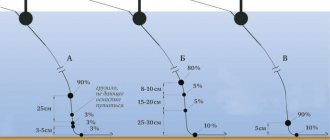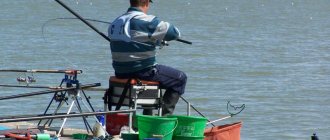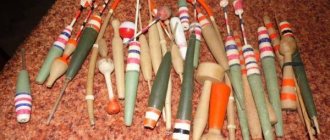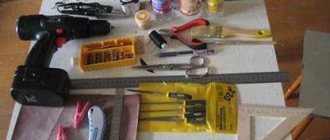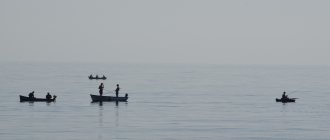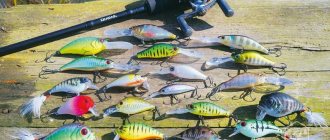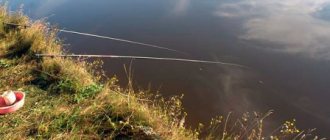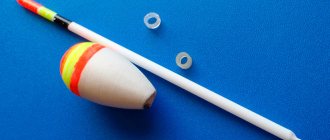A little history
A float with this name first appeared in the arsenal of British match fishing fans in the mid-sixties of the twentieth century. The creator of the best classic “Wagler” at that time was Peter Drennan. His company was the first to mass produce this type of bite indicator.
However, it was difficult to call this production mass production. Each float was made by hand in those days. And since the main material for the production of wagglers was a peacock feather, which was imported from India, the cost of a “mass” float scared off the “mass” buyer. But the quality of "Drennan" was considered standard. Drennan Trademark floats are still in price.
True, before Drennan and simultaneously with him in the fifties and sixties, several British designers were working on similar new type of floats - bite indicators for long-distance casting.
If you dig deeper, the British were not the pioneers of the bite indicator, designed for long casting. Prototypes of floats of this type have been known since the beginning of the twentieth century in Holland.
But manufacturers from Italy became followers of British designers. Most often on the shelves of fishing stores in Europe you can find floats for match fishing, designed and manufactured in Italy.
However, the main trendsetters in the design of classic waggler-type floats have always been and remain today the companies Drennan, Middy and Ultra. True, these companies have recently not been competitors, but have specialized in the production of various types of wagglers.
8 float attachments
Winter roach fishing with a float rod
Have you prepared for summer perch fishing?
Float Wagler
The accessory is characterized by a small cross-section for greater stability and increased sensitivity. The body of the accessory must include granular cork, which prolongs the service life and, in case of hard physical contacts, allows the original appearance and properties to be preserved.
The match float is mainly equipped with an antenna in black, white or bright orange. These colors can be mixed. The tail feather of a peacock is used to make the antenna. The modern Wagler already has two types of weight built in - a constant one, which cannot be changed, and an adjustable one, which allows you to change the weight of the float in accordance with fishing conditions. The second option allows you to load the float with washers through the screws. Such floats are equipped with a hollow inner container into which you can pour water or put lead by adjusting the load.
- Interesting! The marking of floats for match fishing includes several numbers, the first of which indicates the weight of the load, the second - the permissible value of added weight with washers.
In Europe, such accessories are called by a different name - slider floats for match fishing with exactly the same short keel.
What is a waggler
The classic waggler has a heavy, olive-shaped body, a short keel and a long, thick antenna. This is exactly how most anglers imagine it. However, this is not quite true. In Western Europe, any float with one attachment point is often called a waggler.
Just like all floats, the waggler consists of a body, an antenna and a short keel. The body of the float, depending on the model, can be small, massive, like an olive, or long, straight, turning into an antenna.
The antenna of this bite indicator, depending on the model, can have a small (up to 1 mm), medium (up to 5 mm) and large (up to 1 cm) diameter.
The length of the antenna has almost no relation to its diameter. It can be short (about 4 cm), medium (10 – 15 cm), maximum (up to 25 cm). The main role in the antenna of this bite alarm is played by the tip of its antenna.
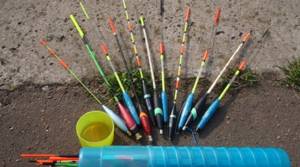
Designers are trying to make it as visible as possible from a long distance. Therefore, the top of the antenna in floats with a straight body always has a bright color (red or orange). In other models, the top of the antenna is always thicker.
The keel of such floats is short and can be made of metal or plastic. Wagglers with a metal keel usually have a variable load. Inside the metal container there are small weights in the form of metal washers, the number of which can be increased or decreased depending on the fishing conditions.
Simpler models have a different system for changing the float load. A special replaceable sinker is inserted into the lower part of the keel. Simple straight models of wagglers do not have sinkers in their design. This float is a simple hollow tube made of transparent plastic, sealed on both sides. The keel in such wagglers is also made of plastic.
Surface Waggler: reverse float
When they talk about floats with one attachment point, they usually mean that this point is located below, on the keel of the float. But there are also floats for which the opposite is true.
To catch carp walking and feeding near the surface, so-called controllers were developed at one time.
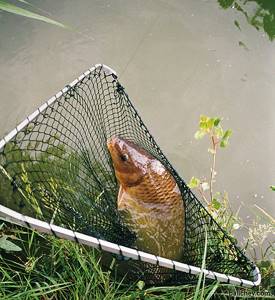
A typical controller is not much different from a carp sinker: oblong in shape, with a ring on top for a fishing line... Only it is not heavier, but lighter than water, and therefore does not lie on the bottom like a sinker, but floats on the surface like a float. The ring through which the line passes protrudes from the water along with the top of the controller, which can be painted in a bright color, like the antenna on a float.
Controller
From a methodological point of view, the controller can be considered, for example, as a sinker of the “vanka-stanka” type, which is not weighted enough so that it does not sink, or as an inverted float, connecting to the fishing line not with the lower, as usual, but with the upper end. Since we are talking about floats, let's imagine it as a self-loading float with a ring on top.
But the carp controller is a heavy thing, designed for casting large baits on thick fishing line with powerful rods. But theoretically, by analogy with it, any waggler can be “turned on its head.” In practice, insert wagglers are best suited for this: a silicone adapter is put on the antenna, which can be made bright red or yellow if desired, and lead wire is wound around the keel, immersing the float all the way to the adapter. In the 90s, this trick was widely used in English ponds, when small fish were caught near the surface with a match fishing rod. Today there is no need to even make something yourself: ready-made “reverse floats” are sold in stores, even in Russia they appear (or appeared) in stores. At one time, Drennan had a Surface Carp Waggler - a loaded, straight waggler with a ring on top.
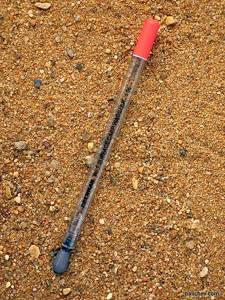
This is a transparent plastic tube with a diameter of about 6 mm, it has a sinker at the bottom, and the upper end is covered with fluorescent paint...
In general, the “reverse float” was used in England back in the 60s. XX century Nothing is new - you just have to dig deep and you will discover that all this has already been tried a long time ago.
Equipment
So, we have in our hands a relatively light float that goes well with a match rod and allows us to very effectively hunt for fish that are located in the uppermost layers of the water. These include small carp in paid “aquarium ponds” of commercial farms, and rudd in lakes and oxbow lakes... But these are also roaches, which sometimes prefer to stay at the top and even chase crusts of bread, rather than sit at the bottom. Why, even tench were seen acting up near the surface! And the crucian carp, diligently eating duckweed?!

Classic case: rudd near the surface
The float is mounted slidingly: the main line is passed through the ring of the adapter or the float itself, depending on the design of the latter. Hence the common name: surface slider . The role of a stopper can be played by a pellet. In the Drennan model, designed, as the name suggests, for carp, the ring will have to be slightly squeezed so that a small pellet does not slip through it. However, I myself prefer a silicone stopper that rests on the knot that connects the main line to the leash; the latter in this case should be long enough.
Several of the smallest pellets are usually evenly distributed along the leash. The bait on such equipment sinks very slowly, and if the fish wants to grab it, it will have time to do so.
Technique
Casting is carried out in the usual manner: in its last phase, the line is slowed down so that the equipment stretches out and lies flat on the point. The tension is maintained even after casting. As a result, the float begins to slowly move towards the fisherman, but this is not scary. Still, it’s better to cast a little further than the target, and only then pull the equipment towards it.
The bites at the surface are always sharp, so it is not at all necessary to submerge the float too much. In the Drennan model described above, a fairly large part protrudes above the water - no big deal. In my opinion, this is even better: it makes it easier to distinguish between fish hitting the fishing line, which can otherwise be easily confused with bites. However, a real bite is usually clearly visible by the movement of the fishing line (“the fishing line has moved”); Moreover, the fish often hooks itself, unless the hook is small and sharp, and the bait does not prevent it from catching. In this sense, it is convenient to catch a cube of uncrushed bread, a maggot, its pupa... In any case, a strong hook is not necessary and even harmful, because everything happens at the very surface, the line is almost tensioned, and a slight movement of the rod is enough to establish contact with the fish.
If there is no bite within 15–20 seconds, then I pull the line, the bait floats up and the process repeats. It’s not scary if the float moves away from the bait: it often happens that the fish stays a little further away. It can also be useful to completely loosen the line so that the nozzle sinks deeper.
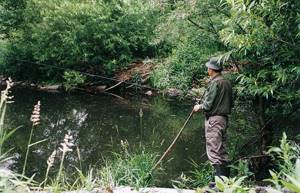
With a float on the old river bed
Lure
There are two options: you can use floating or sinking bait. For example, throw large crusts of bread, around which the water will “boil”, and catch them near them. Or catapult several maggots (pupae) with each cast of the tackle. The second option is not only technically more difficult, but also riskier: if you overdo it with the amount of sinking bait, you will lower some of the fish down and thereby spoil the bite. You can try overexposed, floating pupae or soaked, also floating, maggots. The fish are not always willing to take the first ones, but if they start, they will turn out to be very useful. In all cases, a slingshot is required. You can’t throw either bread or maggots far with your hand.
Data
Drennan Surface Carp Waggler floats were produced in four sizes, Nos. 1–4, differing in body length and built-in weight. Surface Waggler floats are also available under the Middy and Premier . These floats are currently listed at £1.75 on the Premier Floats
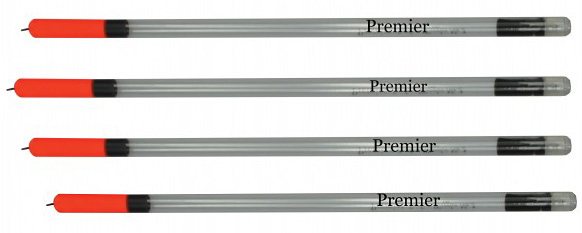
Premier Surface Carp Waggler
Author: D. Balichev Author's photo (4)
Materials for the production of wagglers
To make this bite indicator, various materials were used previously (before Drennan), such as a goose feather, a porcupine quill. The materials were quite expensive and were made by hand, which is why the floats could be very expensive.
The very first classic wagglers were made from peacock feathers, which were brought from India. Currently, in the design of mass-produced long-distance floats, various types of plastics are most often used in combination with balsa. This allowed the products to be significantly cheaper.

Back in the seventies of the twentieth century, there were attempts to produce wagglers from hollow, transparent plastic. (The first models of such floats were produced by Ken Middleton). However, the first attempts did not achieve much success.
The undisputed leader in the production of wagglers, Drennan, appreciated all the advantages of plastic, and soon also created a flexible, multi-purpose float - the Cristal Wagler, which served as a model for numerous imitations. This float is still used by anglers all over the world.
However, elite (expensive, but high-quality) products are always made using natural materials.
The body of this float can be made of balsa (which is actually pressed cork), heavy types of wood, and the keel is almost always metal. Reed or peacock feathers are used to produce antennas for elite floats.
Material
When it comes to the materials from which the waggler is made, we most often mean the body and bite indicator antenna.
A modern waggler can be made from:
- transparent or tinted plastic;
- balsa;
- peacock feather;
The last two materials can be used in production, either separately or in combination (the body of the float is made of balsa, and the antenna is made of peacock feathers). In floats with replaceable antennas, the material for the latter can also be plastic, light metal or reed.
The cost of the material seriously affects the cost of the float, which is why wagglers are more expensive than conventional floats.
Wagler for fishing
Waggler is a name given to a certain type of float that has one attachment point to the fishing line - on the keel. The material used for their manufacture is peacock feather rods or balsa. In the latter case, it picks up a larger number of pellets, which helps the angler cast it over a longer distance.

Unlike rod floats, wagglers can be used both in calm water and in currents. When fishing in deep water, a special locking knot is used, the ring of which has a slightly larger diameter than the main fishing line. Using this option, you can fish the same way as with a sliding float.
When fishing with a waggler, it is preferable to place all the pellets closer to the ring or to the hook. If the float “works” in sliding mode, then with the two largest of them it can be locked in one specific place. All these manipulations will be very helpful when fishing in currents with accompanying wind. If you don’t have the opportunity to use a rod float, a small straight waggler will definitely help out. In this case, the cast should be made a little further from the intended fishing spot. Then the tip of the rod is sharply immersed in the water and the float is pulled to the desired location. When fishing in a current, this maneuver will help to sink the main line, straightening it into a line. After this, the reel is simply opened, allowing it to reel freely, and the float to float with the flow in anticipation of bites. The wagler is almost impossible to control in the same way as a rod float, but with a stretched and submerged fishing line you can get used to it without much difficulty.

Another area of application for the waggler is areas of the river that are located at a considerable distance, as for a rod float. In these cases, in order to throw it in the right place, you will have to tinker a little with the dimensions.
It is quite difficult to achieve stability of the waggler, especially in conditions when the wind outside is too strong. The strong tension of the fishing line created in this case forces the float to go under water for a long time, even without a bite. In order to get out of this situation, the waggler should not be loaded so that its tip protrudes out of the water a little more than usual. Sometimes it is possible to do this so successfully that the float continues to float with the flow, practically without plunging into the water. Attempts to slowly sink it can be safely ignored. In order to continue the movement of the float, it will be enough to simply release a little fishing line from the reel and it will pop out again. If there is a bite, the waggler will stop abruptly and dive into the water. Having noticed this, you need to carry out a regular, long but smooth hook.
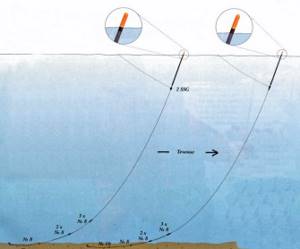
The most difficult operation is considered to subdue the waggler during fishing at considerable distances from the shore with a submerged fishing line. However, for the most part, fishing conditions are quite suitable for fishing with a fishing line floating directly on the surface of the water. In this case, our float does not try to sink, and the resulting excessive sagging of the fishing line is completely eliminated. By the way, sports fishermen are not particularly worried about this. All their attention is focused on the behavior of the float. If he completely disappears from sight, they simply carry out a long, smooth jerk. There is another way. To do this, the rod is moved in an arc of 180 degrees, after which the sagging is eliminated by regular reeling.
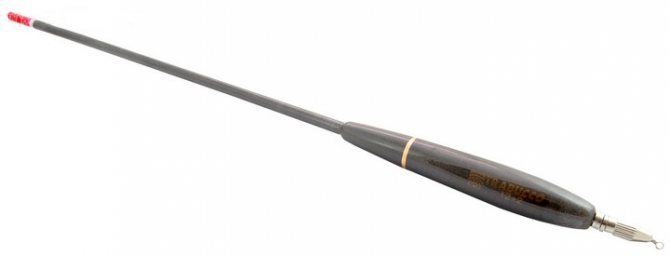
Fishing from medium distances, being on a canal or river, is done with a submerged fishing line. This eliminates the influence of any surface disturbance on it. There are no currents in lakes other than the movement of masses of water driven by the wind, therefore, there will be no problems with flooding. But since there are no conditions for pushing the float out, the waggler must have great sensitivity.
Happy fishing!
Rybolov.ORG - fishing gear at reasonable prices.
Antenna shape, length and diameter
The antenna can have a straight or arrow-shaped (with feathers) shape.
The tops of the waggler antennas can be:
- straight;
- thickened;
- sophisticated;

There are also models of wagglers with replaceable tips.
The length and diameter of the antenna depend on the specific model. The length of classic floats of this type can start from 4 cm. The maximum length in some models can reach 25 cm. The diameter of the antenna also depends on the model.
There are models of wagglers with an antenna with a diameter of 1 mm, but certain types of wagglers have an antenna with a diameter of up to 10 mm. However, most anglers pay attention to the tip of the antenna.

